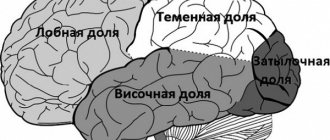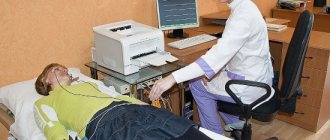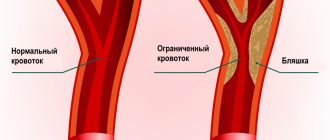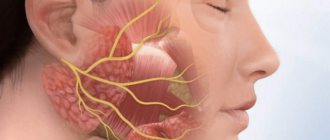80
INTERHEMISPHERE ASYMMETRY
AND THE PROBLEM OF ALCOHOLISM
V.A. MOSKVIN
In modern neuroscience, work is actively underway to study the characteristics of functional brain asymmetries (FAM) not only in local brain lesions, but also in patients of different nosological groups. Deviations in the prevalence of lateral signs are observed in a number of neuropsychiatric diseases - epilepsy, neuroses, psychopathization and deviant behavior. This problem is also being actively studied in defectology: there are works on studying the characteristics of FAM in the blind, deaf, and in patients suffering from logoneurosis and speech underdevelopment, enuresis, and mental retardation [20]. The study of the norm and the connection between individual psychological characteristics and FAM has led to the emergence of such a new direction as the neuropsychology of individual differences [20], [32].
There are also a number of works concerning the study of FAM in chronic alcoholism, but they are characterized by heterogeneity and inconsistency. This article attempts to systematize and generalize
81
the data available in this area, and also present a model of the characteristics of interhemispheric relations in alcoholism (which would be consistent with the results of, if not all, then most studies). Let us immediately make a reservation that we will talk about the biological prerequisites for the development of the disease, which determine the level of psychophysiological health [6].
According to [28], under the influence of alcohol in healthy individuals, recognition of visual stimuli (letters) presented in the left visual field deteriorates. T.N. Reshchikova came to the conclusion that under the influence of alcohol, the right hemisphere loses its advantage in the speed of analyzing information, which indicates its greater sensitivity to alcohol. In patients with chronic alcoholism, the perception time was longer than in healthy people, and a greater deterioration in recognition was observed if letters were presented in the left visual field [28]. E.A. Kostandov also testifies to a significant deterioration in information processing processes in the right hemisphere under the influence of medium doses of alcohol in both healthy people and patients with alcoholism [16].
Yu.L. Arzumanov and G.S. Shostakovich, having studied the EEG in patients with chronic alcoholism, found that the late cortical positive response P300 in all zones was recorded with a longer latency period than in healthy individuals. In patients, the latent period of P300 increased significantly more in the right hemisphere compared to the left, due to which an inversion of the interhemispheric relationships observed in normal conditions occurred. The authors believe that in people with chronic alcoholism, the right hemisphere suffers more than the left [1].
When studying the symmetry of the main types of papillary patterns in 80 patients with alcoholism and 104 healthy subjects, it was found that a greater percentage of symmetry of patterns was observed in patients (67.9 and 60.2%, respectively). It was most significantly increased in the group of patients with a hereditary history of alcoholism. According to the authors, the identified features reflect a violation of signs of right-hand dominance and a constitutional predisposition to alcoholism [30].
A study of the characteristics of the organization of the motivational sphere in patients with alcoholism showed that when presented with slides on alcohol topics, according to EEG data, 56% of them showed signs of activation of the right hemisphere (compared to the background level). In the healthy control group, similar changes were observed only in 39% of cases [4].
L.I. Pandaevsky measured and recorded the total electrical resistance (impedance) of brain tissue in 103 patients with stage II-III chronic alcoholism. Compared to healthy people, patients with alcoholism showed a decrease in impedance by 23% in the right frontal region, by 13.5% in the left frontal region, and by 3.9% in the right occipital region. Based on the data that the value of impedance reflects the functional activity of the cerebral cortex, the author comes to the conclusion that in alcoholism there is a significant decrease in the functional activity of the cortex, more so on the right, and this phenomenon tends to intensify as the disease develops from II to III stage [25].
In patients with chronic alcoholism, hemispheric dominance was studied using dichotic testing. 32 people with diseases of stages I and II were studied and it was found that in patients with stage I, in 81% of cases there was dominance of the left hemisphere and in 19% of the right, and in patients with chronic alcoholism of stage II of the disease, in 63% of cases the left hemisphere dominated and in 37% - right. It was noted that in patients with stage II the predominance
82
the left hemisphere decreases and the percentage of dominance of the right hemisphere increases, which can serve as an additional differential diagnostic criterion [15].
E.V. Gurova and co-authors studied the structure of lateral signs of patients with chronic alcoholism. A total of 504 stage II patients were studied, and the control group included 1316 healthy subjects. Compared to the norm, the percentage of left-handed people among patients was almost twice as high (6.7 and 3.6%). The right type of the “hands crossed” test indicator was less common among patients with chronic alcoholism than among healthy people (35 and 44.1%), as well as the dominant right eye (64.0 and 70.5%, respectively). Among patients with chronic alcoholism, the right type of clapping and the right leading leg were also less common; the same width of the nail beds of the right and left little fingers was more often noted. Thus, a significant accumulation of left-lateral signs in a sample of patients with chronic alcoholism may indicate a predominance of right-hemisphere brain structures in them. The authors believe that this kind of inversion reflects a predisposition to the disease [10].
Analysis of the above works allows us to divide them into two main groups: one of them provides data on special interhemispheric relationships in chronic alcoholism, which are expressed in the predominance of right-hemispheric (or left-lateral) signs of dominance, associated to a greater extent with the constitutional characteristics of patients [10], [ 15], [30]. Based on the available data, a number of authors consider it possible to talk about the right hemisphere lateralization of the “alcohol dominant” [33]. Other authors adhere to the point of view that with alcoholism there is a decrease in the functional capabilities of both the entire brain as a whole and the right hemisphere [1], [16], [25], [28].
A selective effect of a number of drugs on one of the hemispheres of the brain has been revealed, and the administration of seduxen, melipramine and barbamyl leads to inhibition of the right hemisphere and a reciprocal release of activity of the left, while the administration of aminazine and haloperidol leads to inhibition of the left and increased activity of the right hemisphere [12]. These drugs can be considered as neurochemical modulators affecting FAM. Alcohol, thus, can also be considered a modulator of interhemispheric relations, having (at least in the initial stages) a depressing, inhibitory effect on the right hemisphere. Numerous studies have confirmed that inhibition of the functions of the right hemisphere of any origin leads to a reciprocal increase in the activity of the left hemisphere and is accompanied by phenomena of euphoria, disinhibition, verbosity and acceleration of the dynamics of mental processes. The same picture is observed in the first stages of alcohol intoxication. When considering the psychophysiological effect of alcohol on the body, it is traditional to distinguish two phases, or stages, of the development of alcohol intoxication - these are rise, excitation and inhibition, relaxation, depression [7]. The development of the excitation phase upon the onset of alcohol intoxication correlates with data on the selective effect of alcohol on the right hemisphere, its inhibition and the reciprocal release of activity in the left hemisphere. The effects of increased activity and disinhibition may be largely due to the fact that the left hemisphere (at least in the majority of right-handed men) has closer connections with the activating influence of the reticular formation [20]. E.D. Chomskaya also speaks about the presence of asymmetry of brain blocks (including the first - energy), and
83
also that “the left first block predominantly provides various activation modes of the brain” [31; 20].
The approach to the development of the state of alcoholic intoxication, and subsequently the post-intoxication state, from the point of view of interhemispheric relations allows us to consider them as stages of a neuropsychological model of the dynamics of emotional states under the influence of ethanol. The selective influence of alcohol on the right hemisphere leads to the suppression of its functions, which is accompanied by a decrease in criticality and controllability of behavior, a reciprocal release of activity of the left hemisphere and the catecholaminergic system, the development of states of disinhibition and euphoria, increased speech and emotional arousal, and acceleration of the dynamics of mental processes. A similar picture is observed when switching off the functions of the right hemisphere using unilateral electroconvulsive therapy [2]. Subsequently, according to the “pendulum” mechanism, excitation is replaced by a stage of inhibition, which is characterized by an opposite decrease in the functions of the left hemisphere and an increase in the activity of the right hemisphere, leads to the predominance of the serotonergic system and is accompanied by the development of a state of lethargy, a decrease in overall activity, and a predominance of a negative emotional background. Analysis of the dynamics of emotional reactions during the development of alcohol intoxication and alcoholic post-intoxication state is in good agreement with existing neuropsychological ideas about the predominant connection of the left hemisphere with positive emotions, and the right hemisphere with negative emotions [19].
The validity of this model is confirmed in the diagnosis of alcoholic post-intoxication states, which we studied based on the analysis of the course of monocular visual sequential images (VSP). In the work of A.A. Mehrabyan showed that in a third of patients with alcoholism, VPOs do not form at all, while in the rest they are unstable, short-lived, and of low intensity. Taking small and medium doses of alcohol by healthy individuals leads to the disappearance of PVD, recorded by traditional methods (binocularly) for one to three days [18].
A study was carried out to study the characteristics of the course of monocular PVD as an indicator of functional interhemispheric asymmetry in alcohol intoxication and post-intoxication states [14]. For this purpose, 70 healthy subjects (30 women and 40 men) aged 18 to 30 years, right-handed, with a right dominant eye, and 35 patients with stage II chronic alcoholism (men aged 20 to 40 years) were subjected to research. Patients were examined once, outside the period of alcohol intoxication or abstinence. A group of women was also examined once without drinking alcohol. Of the 40 mentally healthy men, 22 were examined four times: before drinking alcohol, during the period of intoxication caused by taking a dose of alcohol of 1 g per 1 kg of body weight, 24 and 72 hours after alcoholization. The visual analyzer was stimulated after a partial three-minute dark adaptation by a 20-second exposure to a red stimulus on a green background. The course of monocular VPOs was recorded according to the subjects' report on the number of waves during the emergence and attenuation of VPOs over 90 s.
In the group of patients with alcoholism, binocular ZPOs were noted in 22 people, which is consistent with the literature data. Monocular ZPOs were formed in only 6 patients, which indicates the high sensitivity of the technique even to lungs
84
cerebral-organic disorder and its inapplicability for the study of patients of this nosological group. In the group of women, monocular ZPOs were absent in five cases, right-sided relative asymmetry was detected in eleven cases, left-sided - in eight cases, symmetry - in six cases. The large variability in the nature of the course of monocular PVD in this group, which is relatively homogeneous in age and lateral phenotype, is consistent with the literature data on the lower severity of FAM in women and indicates the lack of validity of this technique in the study of females.
The results obtained showed that in practically healthy right-handed and right-eyed men, monocular PVs more often occur when stimulating the dominant right eye (which reflects the predominant dominance of the visual parts of the left hemisphere); when drinking alcohol, stimulation of the left eye does not cause PVs, which indicates inhibition of the functions of the right hemisphere, and in a state of post-alcohol intoxication, dominance of the right hemisphere is noted (in the form of left-sided POs). Within the next three days, restoration of the initial level of interhemispheric relations is observed [14]. The results obtained made it possible (together with other data) to formulate the above model of the dynamics of changes in interhemispheric relations at different stages of ethanol intoxication [19].
As is known, psychiatrists distinguish between concepts such as chronic alcoholism and everyday drunkenness [37]. The criterion for the latter is the absence of an uncontrollable craving for alcohol. At the same time, it remains unclear why, under the same social and living conditions, some people quickly develop chronic alcoholism, while others display a fairly high level of tolerance to alcohol and “safely” remain at the level of “everyday drunkenness” for a long time. Even stating the fact that in a sample of patients with chronic alcoholism there is an accumulation of signs of right-hemisphere dominance does not explain how this affects the accelerated development of the disease. In our opinion, the explanation for this fact lies in the presence of individual neurochemical asymmetry [23]. Research by a number of psychologists (R. Cattell, G. Eysenck, S. Gantt) made it possible to establish a connection between blood type and some individual psychological characteristics. It is noted that the immunogenetic characteristics of an individual, manifested in blood groups, are associated with brain functions and show correlations with certain individual psychological characteristics [11]. The neuropsychological approach to the problem of individual differences suggests that differences in cognitive, regulatory and emotional processes are associated with variability in combinations of signs of partial dominance of certain brain structures, which, in turn, manifest themselves in the form of individual laterality profiles [20]. The above data allow us to speak not only about the interhemispheric neurochemical characteristics of a person, but also about the presence of individual neurochemical asymmetry, which is caused by the partial dominance of the corresponding brain structures [23]. The revealed facts of the predominance of left-lateral and right-hemisphere signs in patients with chronic alcoholism [10], [15], [30] indicate not only the relative dominance of the functions of the right hemisphere, but, in our opinion, also the presence of individual neurochemical characteristics in the form of a predominance of right-hemisphere serotonergic activity systems, which results in greater exposure
85
such persons under the influence of alcohol. This is confirmed by clinical observation data. A.P. Chuprikov and I.A. Martsenkovsky found that in patients with the left type of sensorimotor constitution, encephalopathic disorders are symmetrical in nature and develop much faster after a relatively short period of alcoholization. Chronic alcoholism in such patients usually acquires a malignant course with early social maladjustment and personality degradation [35].
Considering the characteristics of alcoholism in left-handed people and ambidextrous people (whose profiles included combinations of left-handedness, dominant left eye and right postural asymmetry), I.A. Martsenkovsky notes that patients with these lateral features are characterized by an early onset of alcoholism, “a much more severe pathological attraction to alcohol, arising without a struggle of motives or taking on the character of an irresistible primary attraction” [17; 126]. Such patients are characterized by rapid social and clinical disruption; they also experience early development of alcoholic psychoses. Another study showed that alcoholism in patients with the left dominant eye develops “in an extremely short time: stage I after 2-5 years; II - 5-9 years; III - 10-12 years of systematic drunkenness" [36; 140]. At the same time, early-onset and rapidly growing encephalopathic manifestations, signs of alcohol degradation and social maladjustment, and the early development of alcohol psychoses are clinically observed [36].
The experience of using lateral therapy methods in narcology shows that only right-lateral subsensory electrical stimulation (which activates the left hemisphere structures of the brain) can relieve withdrawal symptoms in a post-intoxication state in patients with alcoholism [33]. On the contrary, stimulation of the right hemisphere increases the craving for alcohol, making it irresistible. When considering the mechanisms of lateral therapy of chronic alcoholism [34; 45]. Based on the above, it is also concluded that “the attraction to alcohol is associated with the pathological activity of predominantly the structures of the right hemisphere, that is, the pathological determinant structures that provide this attraction have a predominantly right-hemisphere horizontal-lateral organization” [34; 44].
The problem of the peculiarities of interhemispheric relations in alcoholism has another interesting aspect. As already noted, the excitation phase during the development of alcohol intoxication may be more associated with the inhibition of the structures of the right hemisphere and the reciprocal release of activity of the left, which is ensured by closer connections of the reticular formation with the structures of the left hemisphere (at least in the majority of right-handed men). There is an opinion that the reticular formation also plays a major role in the occurrence of paradoxical states, or oneiric activity, in the author’s terminology [13]. J.P. Banquet, when recording interhemispheric asymmetry using EEG during sleep, established that with the development of paradoxical sleep, background right-hemispheric activity changed to left-hemispheric activity [38]. Sh.I. Bibileishvili, when studying using EEG the functional asymmetry of the hemispheres during natural sleep in patients with the consequences of a traumatic brain injury, also found that the dominance of the hemispheres is directly dependent on the type
86
sleep: in slow-wave sleep, the right hemisphere predominates, and in REM sleep, the left hemisphere predominates [3].
M. Jouvet believes that a number of drugs (acting on monoamines) have a suppressive effect on oneiric activity (which, as already mentioned, the author considers as an analogue of paradoxical sleep). If it is suppressed, then this leads to the fact that paradoxical sleep occurs at increasingly shorter intervals, which suggests the accumulation of its deficit. “Any suppression of paradoxical sleep leads to the fact that it later occurs at increasingly shorter intervals. If paradoxical sleep is suppressed for a long time, then during restorative sleep the need for it increases proportionally” [13; 286]. Author Fr. Attention is also drawn to the fact that after cessation of treatment with psychotropic drugs, “a long-term compensatory outbreak of oneiric activity is possible” [13; 295].
When studying sleep patterns using EEG in patients with chronic alcoholism, it was revealed that when recording sleep after taking a small dose of alcohol (1 g per 1 kg of body weight), a reduction in the paradoxical phase was noted in the first half of the night and its complete reduction when taking an average dose ( 2 g per 1 kg of body weight) [5]. If we talk about the phylogenesis of the development of paradoxical sleep, it is known that it reaches its greatest development in humans and mammals, and for predators leading an active lifestyle, paradoxical sleep plays a more important role than for herbivores, ruminants and rodents [13]. It has been established that in animals (rats, cats), the administration of ethanol also causes quite strong changes in the structure of the “wakefulness-sleep” cycle and leads to a decrease in the duration of paradoxical sleep [9].
These data give reason to believe that alcoholic psychoses are a consequence of the accumulation of paradoxical sleep deficit due to inhibition of left hemisphere activity in a post-intoxication state, which subsequently leads to the development of an outbreak of paradoxical brain activity. It is believed that paradoxical sleep can be considered as a functional state of the brain, different from both wakefulness and sleep [13]. Based on this, alcoholic psychoses can probably be considered as manifestations of paradoxical brain activity that develops in the waking state.
Regarding the issue of the characteristics of emotional reactions in alcoholism, the following can be noted: based on the concepts currently existing in neuropsychology, the left hemisphere and its activity are associated with emotions of a positive sign, and the activity of the right hemisphere with emotions of a negative circle. Features of individual styles of emotional response are also noted depending on the predominance of the functions of one or another hemisphere - “right-hemisphere” individuals are more inclined to produce and experience negative emotional states, and also evaluate the same situations more negatively compared to “left-hemisphere” subjects [ 20]. The dominance of right-hemisphere characteristics revealed in patients with chronic alcoholism also determines the predominance of their emotional experiences of the negative circle (or dysthymic mood background, as defined by psychiatrists). Alcohol intoxication in such patients allows one to “brighten” the background mood [8], at least temporarily, which can also be considered as
87
one of the reasons that contributes to the development and consolidation of alcoholism.
Considering the neuropsychological aspects of the problem of alcoholism, we can touch on one more issue. Recently, in the neuropsychology of individual differences, there has been interest in developing the problem of the connection between lateral profiles and subjective time perception [22], [24], [27]. Individual differences in time orientations were revealed in individuals with different variants of individual laterality profiles and the presence of individual differences in the subjective perception of time. It has been established that individuals with a predominance of signs of left hemisphere dominance show a tendency to underestimate time intervals and belong to the tachychronic type, and individuals with a predominance of signs of right hemisphere dominance show a tendency to overestimate time intervals and belong to the bradychronic type. The study of the characteristics of temporal perception in patients with chronic alcoholism was carried out under our leadership V.V. Popovich. It made it possible to establish that patients with alcoholism (in contrast to the control group of practically healthy subjects) are prone to pronounced overestimation and underestimation of time intervals, regardless of the duration of the presented stimulus. According to the scales of subjective time orientation, people suffering from chronic alcoholism are also characterized by a greater focus on the present and past, while the future is less relevant for them [26], which also indicates the amorphous and “blurred” time perspective in patients with this nosology.
It can be assumed that the noted features of temporal perception in patients with chronic alcoholism (to a greater extent) may be due to both the predominance of signs of right hemisphere dominance revealed in them, and a general decrease in the functional capabilities of the brain as the disease develops. Taking into account the fact that the hemispheres of the brain display different strategies for perceiving and assessing time, it can be predicted with a fairly high degree of probability that at different stages of alcohol intoxication the brain will also evaluate time intervals differently. It can be assumed that, in contrast to the initial characteristics of time perception, the bradychronic type of time perception in “right-hemisphere” individuals will change to tachychronic when taking alcohol, which will be determined by suppression of the functions of the right hemisphere and an increase in the activity of the left. In “left-hemisphere” subjects, ethanol suppression of the functions of the right hemisphere in the excitation phase can lead to an increase in the tachychronic type of temporal perception, and in the inhibition stage, the bradychronic type of perception will prevail in them; a change in the parameters of temporal orientation can be observed in the form of a decrease in predictive capabilities and a sense of “time perspective” "
The above facts indicate that individual predispositional characteristics in the form of a predominance of right-hemisphere functions contribute to a more rapid development of alcoholism. At the same time, data from other researchers may indicate that as the disease develops, there is a gradual smoothing of functional features and a decrease in the activity of the entire brain in general and in particular the functions of the right hemisphere, perhaps as more vulnerable [1], [16], [ 25], [28].
The presented data reflect, in our opinion, certain mechanisms
88
interhemispheric effects during the development of a disease such as chronic alcoholism, and allow us to clarify some features of the neuropsychological model we previously proposed for the dynamics of emotional states during ethanol intoxication [19].
Revealing the fact that the predominance of signs of right-hemisphere dominance is an individual predispositional feature that contributes to the more rapid development of alcoholism makes it possible to explain the rather low effectiveness of its treatment in some cases and the prevailing opinion among psychiatrists that “once an alcoholic, always an alcoholic.” B.S. Brother about [6; 241].
At the same time, understanding the presence of individual neuropsychological prerequisites underlying the development of a disease such as alcoholism makes it possible to predict its course. The presented data have additional differential diagnostic and prognostic significance when conducting forensic psychological examinations [22]. They can also be used for the purposes of professional selection and career guidance [21].
1. Aruzmanov Yu.L., Shostakovich G.S.
Interhemispheric asymmetry of evoked potentials in patients with chronic alcoholism // Interrelations of the brain hemispheres. Tbilisi: Metsniereba, 1982. P. 158.
2. Balonov L.Ya., Deglin V.L.
. Hearing and speech of the dominant and non-dominant hemispheres. L.: Nauka, 1976.
3. Bibileishvili Sh.I.
Functional asymmetry of the cerebral hemispheres during natural sleep in patients with closed traumatic brain injury // Clinical aspects of the modern problem of functional brain asymmetry. Minsk: MGMI, 1989. pp. 6 - 7.
4. Bobrov A.E.
Psychophysiological and medical aspects of the problem of personality change in alcoholism // Psychologist. magazine 1986. T. 7. No. 2. P. 89 - 95.
5. Bogdanov K.A
. et al. Some electrophysiological indicators of sleep and wakefulness in patients with alcoholism // Modern problems of neurobiology. Tbilisi: Metsniereba, 1986. pp. 47 - 48.
6. Bratus B.S.
. Personality anomalies. M.: Mysl, 1988.
7. Bratus B.S., Sidorov P.I.
. Psychology, clinic and prevention of early alcoholism. M.: Moscow State University Publishing House, 1984.
8. Vaynerovich A.A.
et al. Dysthymic disorders in patients with alcoholism and their treatment // Typology and structure of depression. Voroshilovgrad. 1986. pp. 106 - 107.
9. Gogichadze M.V.
et al. The influence of acute alcohol intoxication on the wakefulness-sleep cycle in laboratory animals // Modern problems of neurobiology. Tbilisi: Metsniereba, 1986. pp. 101 - 102.
10. Gurova E.V., Drozdov E.S., Klein V.N.
. Features of the lateral phenotype in alcoholism // Left-handedness, anthropoisomerism and lateral adaptation. M.; Voroshilovgrad, 1985. P. 102 - 103.
11. Danilova N.N.
Psychophysiological diagnostics of functional states. M.: Moscow State University Publishing House, 1992.
12. Egorov A.Yu.
Psychotropic drugs and interaction of the brain hemispheres // Clinical aspects of the modern problem of functional asymmetry of the brain. Minsk: MGMI, 1989. pp. 25 - 27.
13. Jouvet M.
Oneiric activity and neuropharmacology // Electronic computing technology in the study of disorders of human mental activity / Ed. N. Klein, E. Laska. M.: Medicine, 1971. S. 283 - 297.
14. Klein V.N., Moskvin V.A.
. On the diagnosis of alcoholic post-intoxication states for the purpose of primary prevention of alcoholism // Current issues in narcology. Kharkov, 1985. S. 25 - 27.
15. Kovtun T.V., Golova I.D.
. Study of functional asymmetry in patients with chronic alcoholism // Problems of neurocybernetics. Rostov-n/D: RSU Publishing House, 1989. P. 218.
16. Kostandov E.A
. Functional brain asymmetry and unconscious perception. M.: Nauka, 1983.
17. Martsenkovsky I.A.
Clinical features of drunkenness and alcoholism in left-handed people and ambidexters // Left-handedness in children and adolescents. M.: All-Russian Research Institute of Hygiene for Children and Adolescents, 1987. pp. 124 - 128.
89
18. Mehrabyan A.A., Avakyan S.L., Harutyunyan R.K.
. Electroencephalographic characteristics of visual sequential images in some mental illnesses // Proc. Yerevan medical in-ta. 1960. Issue. II. P. 373.
19. Moskvin V.A.
Dynamics of emotional states in alcoholism: neuropsychological analysis // VII edition of neuropathologists, psychiatrists and narcologists of the Ukrainian RSR. Theses of additional information. Kharkiv, 1990. Part II. pp. 219 - 220.
20. Moskvin V.A.
Individual profiles of laterality and some features of mental processes (in normal and pathological conditions): Cand. dis. M., 1990.
21. Moskvin V.A.
Neuropsychological criteria for the selection and training of managers // Problems of management and market. Orenburg: OSU Publishing House, 1996. pp. 236 - 238.
22. Moskvin V.A.
Forensic psychiatry and neuropsychology // Social and forensic psychiatry: history and modernity / Ed. T.B. Dmitrieva. M.: RIO GNTsS and SP im. V.P. Serbsky, 1996. pp. 324 - 326.
23. Moskvin V.A.
Neurochemical asymmetry and individual characteristics // Psychiatric Archives. VIP. 12 - 13. Asymmetry of the cerebrum is normal with pathology. Kiev, 1997. P. 39.
24. Moskvin V.A., Popovich V.V.
. Individual profiles of laterality and subjective perception of time // Technologies of the educational process. Part II. Orenburg: OSU Publishing House, 1997. P. 110.
25. Pandaevsky V.V.
. Impedance study in narcology // Non-drug (bi- and unilateral) therapy in narcology, psychiatry and neurology. Donetsk, 1988. P. 16.
26. Popovich V.V.
Features of temporal perception in patients with chronic alcoholism // Abstracts of reports of the regional conference. young scientists and specialists. Part III. Orenburg: Publishing house. Center OGAU, 1998. P. 5 - 7.
27. Popovich V.V., Moskvin V.A.
Neuropsychological approach to assessing the subjective perception of time // Abstracts of the 1st International. conf. in memory of A.R. Luria. M.: Moscow State University Publishing House, 1997. pp. 77 - 78.
28. Reshchikova T.N.
The influence of alcohol on interhemispheric functional relationships in humans // Interrelations of the brain hemispheres. Tbilisi: Metsniereba, 1982. P. 194.
29. Simernitskaya E.G., Polyakov V.M., Moskovichute L.I.
. Neuropsychological analysis of the role of biogenic amines in the functional organization of the human brain // Modern problems of neurocybernetics. Tbilisi: Metsniereba, 1986. pp. 329 - 330.
30. Skugarevskaya E.I., Skugarevskaya O.A.
The relationship between the symmetry of dermatoglyphic indicators and predisposition to alcoholism // Left-handedness, anthropoisomerism and lateral adaptation. M.; Voroshilovgrad, 1985. pp. 103 - 104.
31. Khomskaya E.D.
About the asymmetry of brain blocks // Neuropsychology today. M.: Moscow State University Publishing House, 1995. pp. 14-27.
32. Khomskaya E.D.
. et al. Neuropsychology of individual differences. M.: RPA, 1997.
33. Chuprikov A.P., Bondarenko V.K., Klein V.N.
. Right hemisphere lateralization of the alcoholic dominant // Problems of neurocybernetics. Rostov-n/D: RSU Publishing House, 1983. P. 252.
34. Chuprikov A.P., Linev A.N., Martsenkovsky I.A.
. Lateral therapy. Kyiv: Health, 1994.
35. Chuprikov A.P., Martsenkovsky I.A.
On the issue of interhemispheric functional relationships at different stages of alcoholism and withdrawal syndrome // Non-drug (bi- and unilateral) therapy in narcology, psychiatry and neurology. Donetsk, 1988. pp. 14 - 15.
36. Chuprikov A.P., Martsenkovsky I.A.
Some clinical features of alcoholism and alcoholic psychoses in men with a left dominant eye // Issues of psychiatric and drug treatment for the rural population. New in lateral neuropsychiatry. Donetsk, 1990. P. 1409.
37. Shumsky N.G.
Alcoholism // Guide to Psychiatry / Ed. A.V. Snezhnevsky. M.: Medicine, 1983. P. 251 - 328.
38. Banquet J.P.
Interhemispheric asymmetry during sleep // Sleep. Basel, 1983. P. 178 - 181.
Received by the editors on October 19, 1998.
Introduction
In recent years, scientific research has shown significant changes in the functional asymmetry of the brain in children.
Until the 70s, the number of left-handed people was constant and amounted to 7-8% of the population [Lokhov M.I. et al., 2005], similar data of 5-10% of 800 examined primary school students from A.V. Semenovich, F.F. Tsyganok, [1995, p.175].
However, unlike Russia, in the USA in the 80s there was already an increase in left dominance to 10-30% [Whitaker, 1983; Hatta, 1988]. This caused surprise and healthy wariness in the scientific community, which had conducted research a decade earlier [Blumstein, et.al., 1975; Teng, 1981; Trachenko O.P., 1995; and etc.]. That is, literary data indicate changes in the structure of laterality in different countries and that this process occurred unevenly.
It turned out that both left- and right-handers are heterogeneous groups. Within each group, lateral signs may differ in the leading arm, leg, ear, eye, electrical axis of the heart, and, finally, the characteristics of brain activity itself [Makaryev I.N., 1995; Martynova S.M., et al., 2006; Semenovich A.V., 2005, p. 158-162, etc.].
In the same 80s, attention was paid to the growing population of left-handed children and children with hidden left-handedness. Their number in the 90s increased to 15-17%. Then reports appeared about a qualitatively different group of children - ambidextrous, “two-handed”. At first, ambidexterity, like left-handedness, was regarded as “inferior development”, or as a variant of developmental disorder. Ten years later, attitudes towards ambidexterity have changed dramatically. Today this is one of the norm options. (Moreover, these changes in the population may help reconsider some approaches to diagnosis and correction in children with ADD/ADHD ).
Such children, apparently, have always existed. It’s just that in past decades their number in population studies was negligible - 1-2%.[4].
In recent years, we have seen an increase in the number of such children. Thus, according to the results of neuropsychological testing of Moscow schoolchildren, [S.M. Martynova et al., 2006] found an increase not only in left laterality, but also an increase in the number of children with no manifestations of asymmetry. The authors note the dominance of the right hemisphere in 1st grade students in 47.8% of cases; 4th grade - 44.8%; 9th grade - in 52.6-66.6% of cases. Dominance of the left hemisphere in 1st grade students is expressed in 34.8% of cases; 4th grade - 37.9%; 9th grade - 10.5%. There was also a significant number of children called by the authors “children with no manifestations of asymmetry”, respectively, in 1st grades - 17.4%, 4th grades - 17.2% and 29.0-36.8% for students 9- x classes. That is, we see an increase in left laterality and ambidexterity compared to the data of the 80s.
Results
We examined 212 schoolchildren from 4 Moscow schools.
Table.











